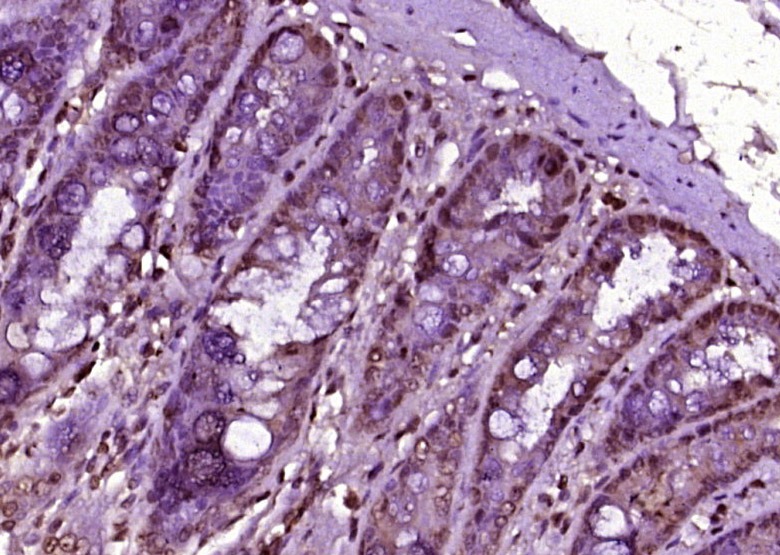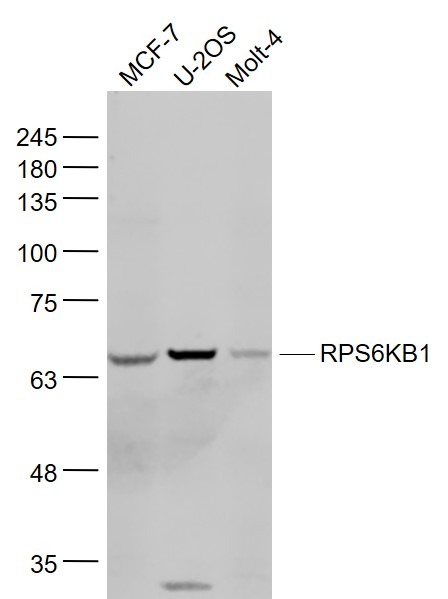Shopping Cart
Remove All Your shopping cart is currently empty
Your shopping cart is currently empty
Anti-S6K1/RPS6KB1 Polyclonal Antibody is a Rabbit antibody targeting S6K1/RPS6KB1. Anti-S6K1/RPS6KB1 Polyclonal Antibody can be used in IF,IHC-Fr,IHC-P,WB.
| Pack Size | Price | USA Warehouse | Global Warehouse | Quantity |
|---|---|---|---|---|
| 50 μL | $220 | 7-10 days | 7-10 days | |
| 100 μL | $372 | 7-10 days | 7-10 days | |
| 200 μL | $527 | 7-10 days | 7-10 days |
| Description | Anti-S6K1/RPS6KB1 Polyclonal Antibody is a Rabbit antibody targeting S6K1/RPS6KB1. Anti-S6K1/RPS6KB1 Polyclonal Antibody can be used in IF,IHC-Fr,IHC-P,WB. |
| Synonyms | STK14A, S6K-β-1, S6K-beta-1, S6K1, S6K, RPS6KB1, ribosomal protein S6 kinase, polypeptide 1, PS6K, p70-α, p70-S6K, p70-alpha, p70(S6K)-α, p70(S6K)-alpha, p70 S6KA |
| Ig Type | IgG |
| Reactivity | Human,Rat (predicted:Mouse,Chicken,Dog,Pig,Cow,Horse,Rabbit,Goat) |
| Verified Activity | 1. Paraformaldehyde-fixed, paraffin embedded (rat colon tissue); Antigen retrieval by boiling in sodium citrate buffer (pH6.0) for 15 min; Block endogenous peroxidase by 3% hydrogen peroxide for 20 min; Blocking buffer (normal goat serum) at 37°C for 30 min; Antibody incubation with (RPS6KB1) Polyclonal Antibody, Unconjugated (TMAB-01647) at 1:400 overnight at 4°C, followed by operating according to SP Kit (Rabbit) instructionsand DAB staining. 2. Sample: MCF-7 (Human) Cell Lysate at 30 μg U-2Os (Human) Cell Lysate at 30 μg MOLT-4 (Human) Cell Lysate at 30 μg Primary: Anti-RPS6KB1 (TMAB-01647) at 1/1000 dilution Secondary: IRDye800CW Goat Anti-Rabbit IgG at 1/20000 dilution Predicted band size: 70 kDa Observed band size: 68 kDa   |
| Application | |
| Recommended Dose | WB: 1:500-2000; IHC-P: 1:100-500; IHC-Fr: 1:100-500; IF: 1:100-500 |
| Antibody Type | Polyclonal |
| Host Species | Rabbit |
| Subcellular Localization | Cytoplasm; Nucleus. Cytoplasm and Cell junction > synapse > synaptosome. Mitochondrion outer membrane. |
| Tissue Specificity | Widely expressed. |
| Construction | Polyclonal Antibody |
| Purification | Protein A purified |
| Appearance | Liquid |
| Formulation | 0.01M TBS (pH7.4) with 1% BSA, 0.02% Proclin300 and 50% Glycerol. |
| Concentration | 1 mg/mL |
| Research Background | This gene encodes a member of the ribosomal S6 kinase family of serine/threonine kinases. The encoded protein responds to mTOR (mammalian target of rapamycin) signaling to promote protein synthesis, cell growth, and cell proliferation. Activity of this gene has been associated with human cancer. Alternatively spliced transcript variants have been observed. The use of alternative translation start sites results in isoforms with longer or shorter N-termini which may differ in their subcellular localizations. There are two pseudogenes for this gene on chromosome 17. [provided by RefSeq, Jan 2013] |
| Immunogen | KLH conjugated synthetic peptide: human RPS6KB1 |
| Antigen Species | Human |
| Gene Name | RPS6KB1 |
| Gene ID | |
| Protein Name | Ribosomal protein S6 kinase beta-1 |
| Uniprot ID | |
| Biology Area | Rb,DNA Damage Recognition,Ribosome,Obesity,S6K Family |
| Function | Acts to integrate nutrient and growth factor signals in regulation of protein synthesis, cell proliferation, cell growth, cell cycle progression and cell survival. Downstream effector of the mTOR signaling pathway. Phosphorylates specifically ribosomal protein S6 in response to insulin or several classes of mitogens. During translation initiation, the inactive form associatess with the eIF-3 complex under conditions of nutrient depletion. Mitogenic stimulation leads to phosphorylation and dissociation from the eIF-3 complex and the free activated form can phosphorylate other translational targets including EIF4B. Promotes protein synthesis by phosphorylating PDCD4 at 'Ser-67' and targeting it for degradation. Phosphorylates RICTOR leading to regulation of mammalian target of rapamycin complex 2 (mTORC2) signaling; probably phosphorylates RICTOR at 'Thr-1135'. Phosphorylates IRS1 at multiple serine residues coupled with insulin resistance; probably phosphorylates IRS1 at 'Ser-270'. Required for TNF-alpha induced IRS-1 degradation. Phosphorylates EEF2K in response to IGF1 and inhibits EEF2K activity. Phosphorylates BAD at 'Ser-99' in response to IGF1 leading to BAD inactivation and inhibition of BAD-induced apoptosis. Phosphorylates mitochondrial RMP leading to dissociation of a RMP:PPP1CC complex; probably phosphorylates RMP at 'Ser-99'. The free mitochondrial PPP1CC can dephosphorylate RPS6KB1 at Thr-412 which is proposed to be a negative feed back mechanism for the RPS6KB1 antiapoptotic function. Phosphorylates GSK3B at 'Ser-9' under conditions leading to loss of the TSC1-TSC2 complex. Phosphorylates POLDIP3. |
| Molecular Weight | Theoretical: 70 kDa. |
| Stability & Storage | Store at -20°C or -80°C for 12 months. Avoid repeated freeze-thaw cycles. |
| Transport | Shipping with blue ice. |
| Size | Quantity | Unit Price | Amount | Operation |
|---|

Copyright © 2015-2025 TargetMol Chemicals Inc. All Rights Reserved.